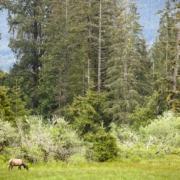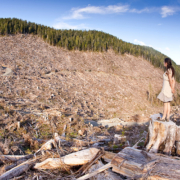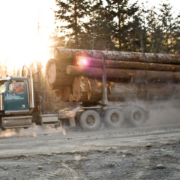‘Big trees’ of Avatar Grove are pure magic
There are some places so precious that just standing there makes you proud to be a Canadian.
Avatar Grove is one of those.
Some of the oldest, biggest, and most gnarly trees in the country stand in these woods, found by hikers like T.J. Watt. He’s so passionate about ancient forests, the professional photographer calls himself a “big tree hunter.”
“I knew that only 4% of the old-growth forest was left in southern Vancouver Island,” he says, while hiking in the woods near Port Renfrew, at the far western edge of Canada. “For the most part, we just saw large stumps. Basically, I thought there was no hope of finding ancient trees.”
But Watt was determined, and his search along the Gordon River here led him through thick undergrowth to massive red cedars and Douglas firs.
He found enough giants in the forest in late 2009 to alert Victoria biologist Ken Wu, then with the Western Canada Wilderness Committee. By the time the pair returned in January 2010, trees in the grove already had been flagged for logging.
“We couldn’t leave them,” Watt says in a strangled voice. “Those logging flags were just unbelievable. We had a real sense of urgency about saving these trees.”
The men immediately founded the Ancient Forest Alliance, drawing such international attention they had 15,000 hits on their Facebook page in only a few days.
“We knew it could be gone in a month or so, and then we held a press conference in the forest. We didn’t have any bank account, but we got media attention around the world,” Watt recalls.
International students from Korea, Mexico, Japan, and Brazil, all studying at the University of Victoria, joined Canadian naturalists in visiting Avatar Grove, named for the fantasy landscape in James Cameron’s movie, Avatar.
Public pressure mounted for saving the trees, and in February, the BC government declared a 59-hectare chunk of forest off-limits to logging. Provincial tourism officials were so excited by new visitors arriving in Port Renfrew, they added Avatar Grove and other tree sites to “natural wonders” along the new Pacific Marine Circle Route.
In addition to the spectacular Avatar Grove, the 74-metre-tall “world’s largest Douglas fir” is also in Port Renfrew, along with the 68-metre San Juan Spruce, tallest in Canada and second tallest in the world. Together, these trees have made Port Renfew the “big trees capital of Canada.” Some are are estimated to be close to 1,000 years old.
Port Renfrew is known already as one of the best spots to get fresh food, hot shower, and a cosy bed for those starting or leaving the rugged 75-km West Coast trail. (Reservations must be made through Parks Canada. Peak hiking season is mid-June to mid-October.) Port Renfrew is also the terminus for the Juan de Fuca Marine Trail, a 47-km wilderness trek along the southwest coast of Vancouver Island.
“Port Renfrew has traditionally been a resource-based town, with logging and fishing,” says Watt, whose dad owns the Port Renfrew Marina. “What’s bringing people now are the trees.”
Jessica Hicks, co-owner with husband Tom Wyton, of the Coastal Kitchen Cafe, says the surge in international travellers has been “incredible.”
A couple of visitors a day would ask directions to ancient trees just last year, and now it’s 40 or more a day, she says. Local businesses had to produce more maps to keep up with demand.
“It’s a forever thing,” she says. “Hundreds, then thousands of people are coming from all over the world, from the Gulf Islands to Germany to see the trees. It’s not crowded, and we really like these people — they respect the environment.”
AVATAR MOVIE INSPIRES AN ECO-TRAVEL DESTINATION
Hicks says after 12 years in business in Port Renfrew, she’s been “amazed” by the extra business in the past two years. “T.J. and the others have really made a difference here,” she says. “It’s awesome — interest is growing, but it’s not so huge that anyone is producing Avatar Grove T-shirts yet.”
Brothers Jon and Tim Cash, chefs from Toronto, bought a large oceanfront property and added a luxury lodge with private cabin and three upscale yurts, all with Pacific or San Juan Inlet views. Their Soule Creek Lodge opened in 2001.
“More people are more interested in the trees than Botanical Beach, which used to be the big draw,” says Jon Cash, former Chamber of Commerce president here. “The beach would draw 60,000 people a year and now, it’s all about the trees. People will drive across the country to find the largest tree.”
Guests from the Netherlands, France, and England are drawn by eco-marketing of the “Jewel of the West Coast,” and Cash says he’s now handing out thousands of maps for self-guided tours of the big trees, compared to hundreds just a few years ago.
Visitors are drawn not only by the ancient giants, but wildlife, including Roosevelt elk, deer, wolves, bears, and cougars. Pileated woodpeckers, hawks, and bald eagles are common.
Hikers can roam the woods for hours without seeing anyone. Some hikes, like Avatar Grove, are more demanding, so the Ancient Forest Alliance assesses hiking difficulty on its website.
Watt is still searching for more ancient trees, figuring he just found the “eighth-largest Douglas fir in Canada,” estimated at more than three metres in width.
These giant trees can be found less than a half hour from the road in Port Renfrew. (TJ Watt photo)
It’s not recommended for novices, but Watt climbed the San Juan Spruce and found eagles near its top. Branches were so dense, they support a mat of “suspended soil in the mass a foot thick,” he says. “It really shows what we’ve got and what we could be losing.”
The Ancient Forest Alliance is campaigning to have Avatar Grove protected as a provincial park, and is raising money to build a boardwalk to make the giant trees there more accessible. (See its Facebook page.)
“We have an opportunity to leave behind a green legacy, of saving the last of the old-growth forests, or we could be the last liquidators of the ancient forest,” Watt cautions. “Most old growth is tucked away in valleys and so it’s hard to see.”
Avatar Grove and the other giants here are less than a half-hour from the road.
MORE ABOUT AVATAR GROVE
Location. The forest is about a two-hour drive west of Victoria along Highway 14, a paved road that is mostly two lanes. There’s no gas station, so be certain to fill up before heading to Port Renfrew.
Where to Stay: There’s camping, RV sites, cabins and two main hotels, Soule Creek Lodge ($145-$215/night, including breakfast; $36 dinner for guests only, BYOB) and Port Renfrew Resorts ($190 and up/night for waterfront, log cabins).
Dining Tips: Bison burgers and fish and chips are popular at Coastal Kitchen Cafe, but hardly anyone leaves without a platter-sized, chocolate pecan cookie. They’re $3 and homemade daily.
The pub at Port Renfrew Resorts has a pool table and big-screen TVs indoors and an outdoor deck overhanging the San Juan Inlet. It also features aboriginal art and carving throughout the grounds, and historical photos of area fishing and logging.
Soule Creek Lodge asks guests each morning about food allergies and preferences, then the chefs prepare a feast with local, seasonal ingredients. Fresh-from-the-dock fish includes sockeye salmon, tuna, and halibut, all wild and caught nearby.






